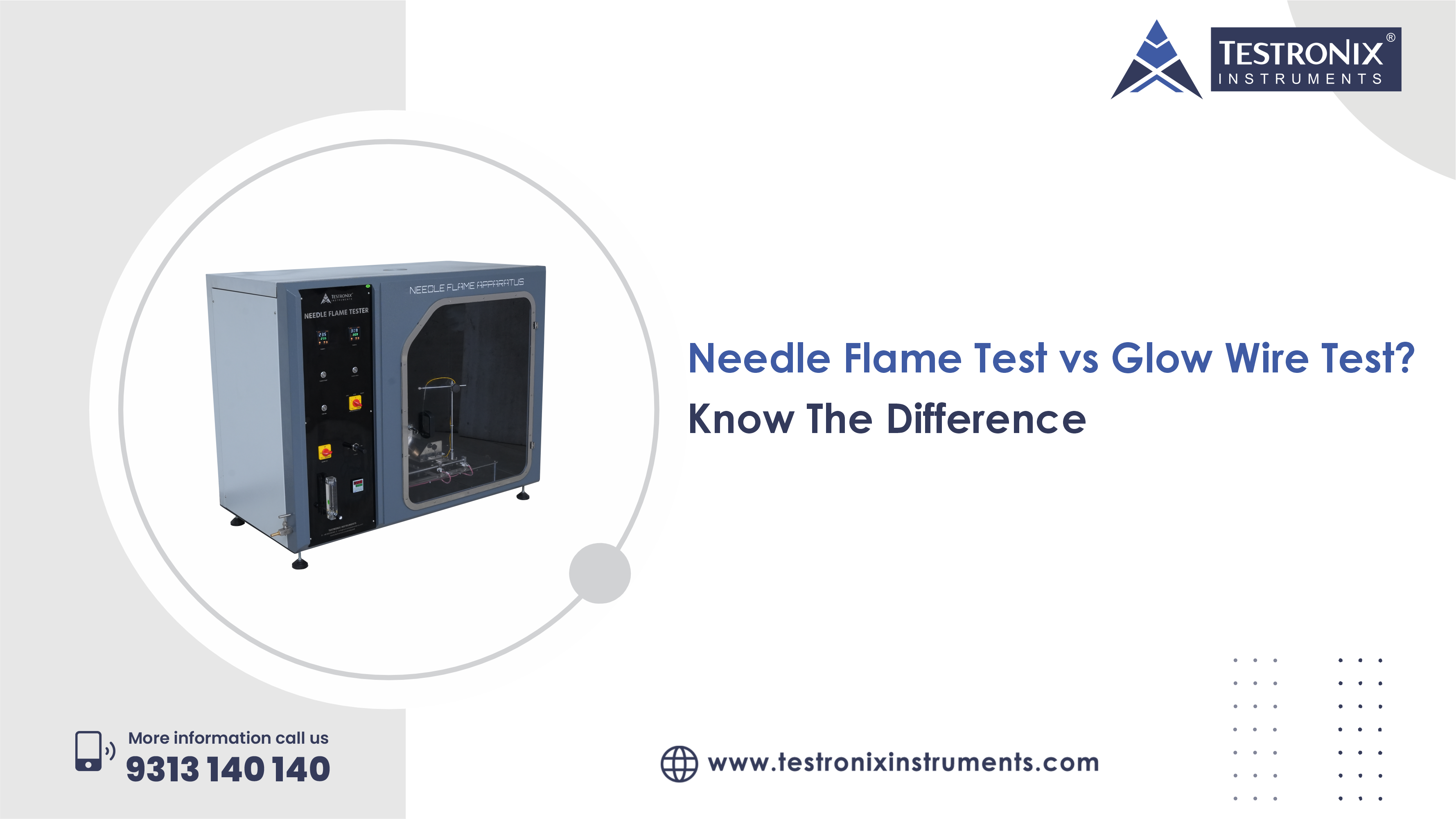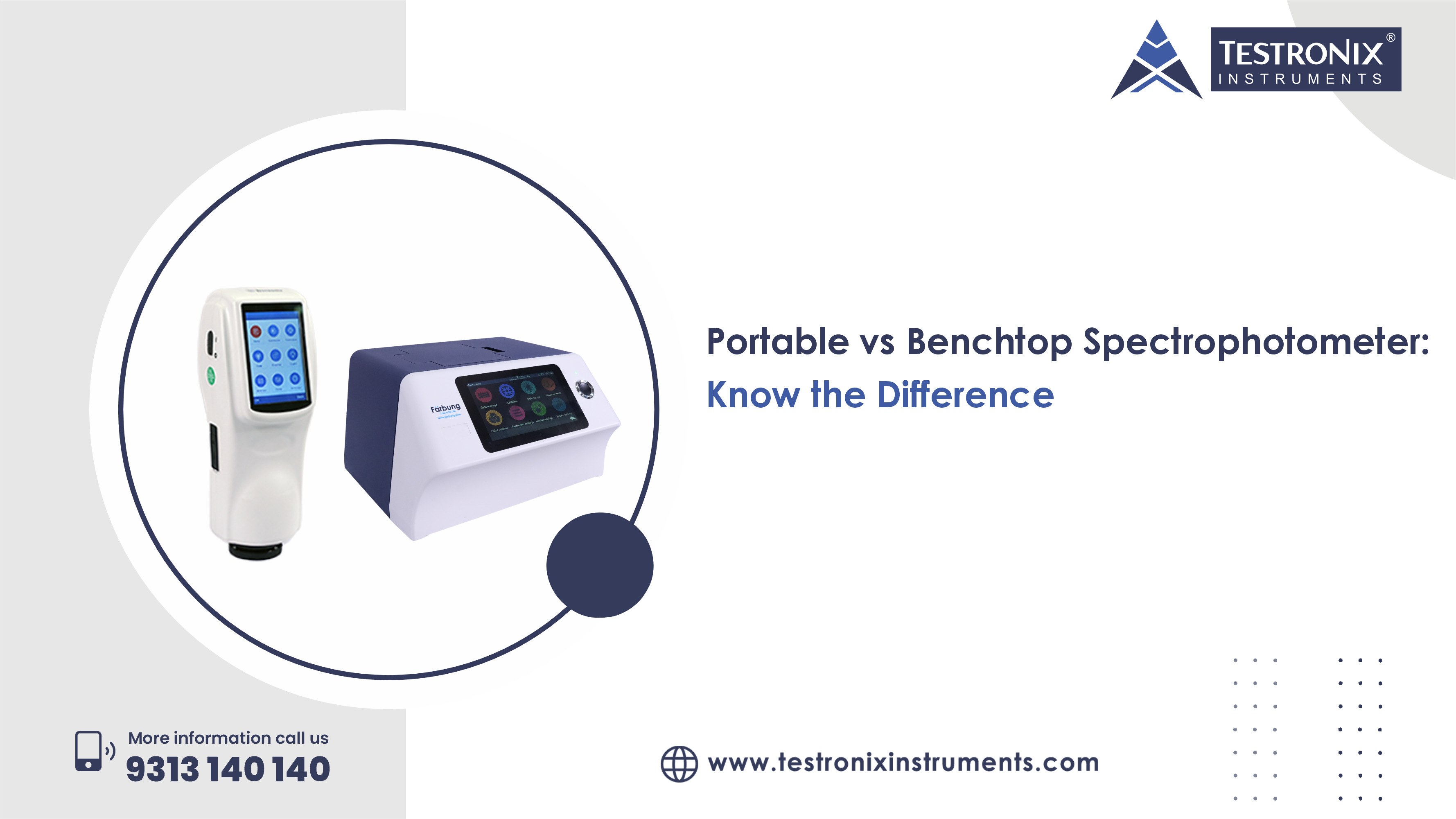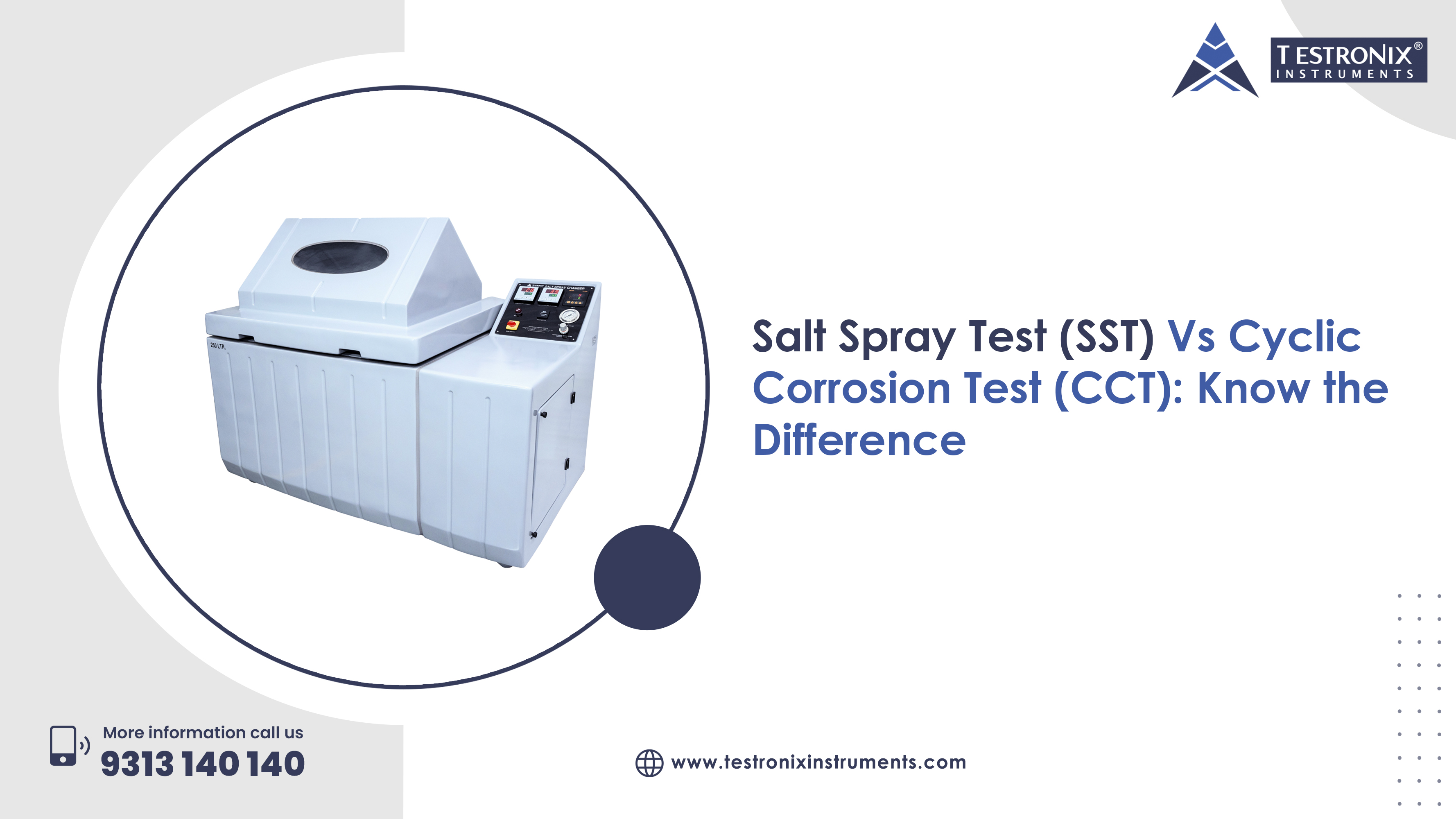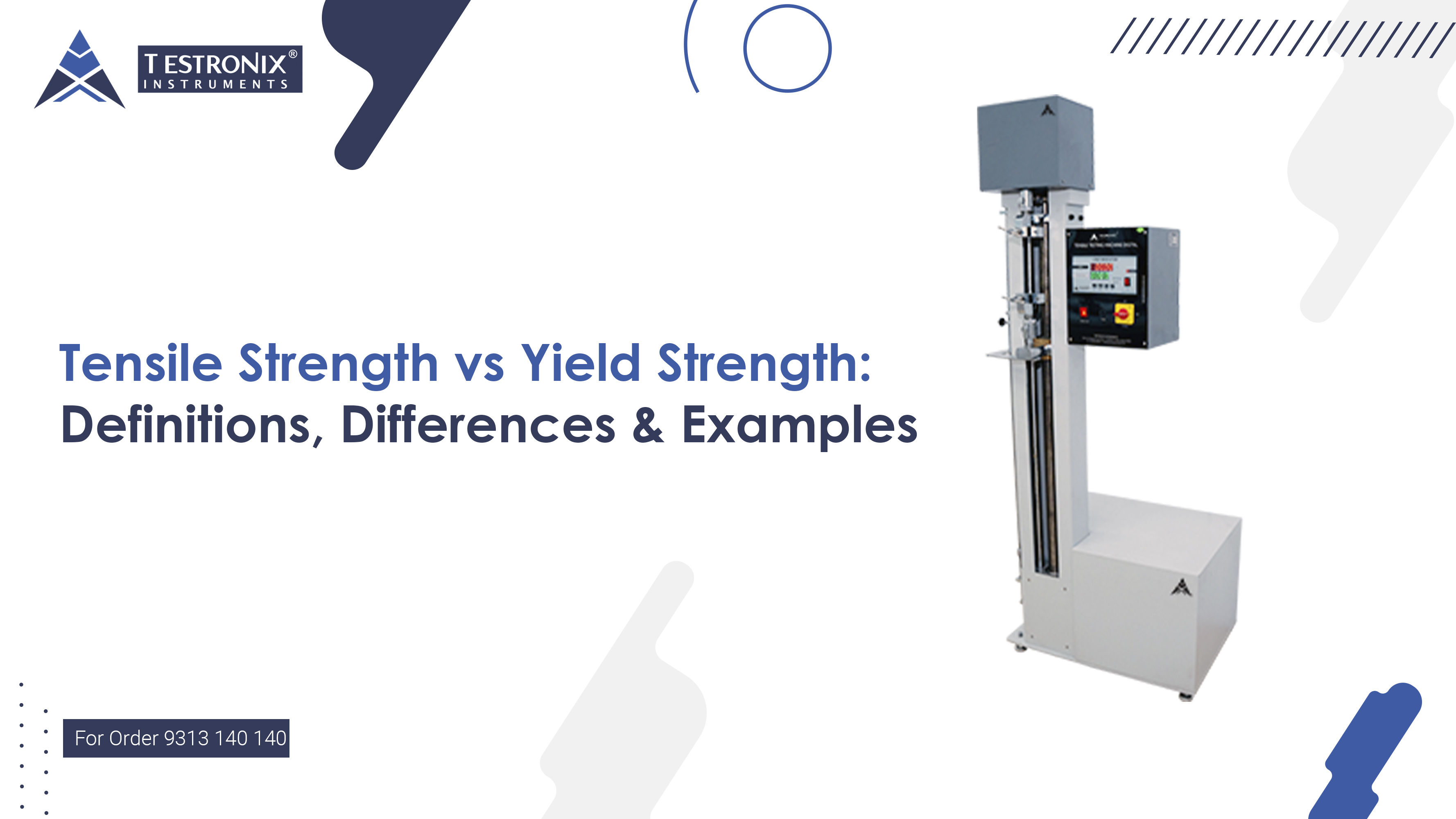The Needle Flame Test and Glow Wire Test are two fire safety test methods that are fundamentally different evaluations of resistance to ignition and flammability of electrical and plastic materials. Both tests examine the reaction of the material to heat and flame but the tests and purposes are distinct. Learn how they differ in ensuring the safety of the product and compliance with ISO (International Standards Organization).
What is the Needle Flame Test?
A Needle Flame Test is an established procedure for evaluating the flammability of materials and components in electrical and electronic equipment with respect to small flame exposure. The test assesses how a material responds to a small flame, whether it ignites or propagates, as a worst-case scenario if a malfunction occurs inside the equipment (short circuit, thermal degradation, etc.).
Working Principle of Needle Flame Test
In this test, a small, standardized needle flame is applied to a given material for a specific period of time, usually with the primary goal of assessing its resistance to fire.
This test intends to mimic a small flame that could occur in an electrical fault scenario (i.e., overheating in a component) and observe material behaviors such as ignition, after flame time, flame spread, or the tendency to produce flaming droplets.
Uses of Needle Flame Test
The Needle Flame Test is a common procedure to evaluate the fire resistance of materials in electrical and electronic products. In the electrical and electronic industry, this needle test serves as a measure for various components including connectors, switches, circuit boards, cable insulation, and enclosures. The test assures that the materials will resist ignition, limit flame spread, and provide a viable demonstration of compliance with the minimum fire safety necessarily required.
What is the Glow Wire Test?
The Glow Wire Test is a safety standard to evaluate how combustible and fire-resistant electrically insulating materials and electrically insulating components are when subjected to a non-flame heat source using heat that imitates the thermal stress of a malfunctioning, overheated electrical component.
Working Principle of Glow Wire Test
In the glow wire evaluation, a nichrome wire (glow wire) is heated to a specified high temperature. The wire is then placed in contact with a specimen for a set duration (30 seconds) to replicate a high-temperature situation. The glow wire evaluation is used to assess flammability and thermal stress to determine a material's resistance to ignition and ability to self-extinguish.
Uses of Glow Wire Test
This test is generally used in electrical and electronic sectors to measure the safety performance and align with standards. It is especially used when evaluating unattended appliances where a minor fault could create a fire hazard. Typical applications are to test plastic casings, switches, sockets, connectors, printed circuit boards (PCBs), and other polymer parts found in home appliances, IT equipment, lighting, and industrial control equipment.
Needle Flame Test vs Glow Wire Test? Know the Difference
The primary difference is the source of the ignition: the needle flame test simulates a very small and direct flame, much like a small, localized electrical arcing event. The glow wire test simulates the typical overheating of electrical equipment, such as a resistor, and all electrical components would have a glow wire test done on them. The needle flame test looks at the material's performance in a very small and direct flame, and it does this by measuring both the ignition time and the spread of the flame. The glow wire evaluates a material's ability to resist ignition from heat.
Here is the major difference explained in tabular form:
|
Feature |
Needle Flame Test |
Glow Wire Test |
|
Ignition Source |
A small, standardized, needle-like flame (e.g., from butane). |
A heated element or wire simulates the overheating of a component. |
|
Simulates |
A localized, direct flame fault, such as electrical arcing, is simulated. |
The simulation focuses on an overheated component within an electrical device, such as a resistor or connection. |
|
Primary Goal |
The primary goal is to determine whether a small flame will ignite the part or if it will quickly self-extinguish and not spread. |
To assess the material's ignition temperature (GWFI) and its ability to self-extinguish after exposure to high heat. |
|
Application |
More applied and often more severe; used for end-products and sub-assemblies to evaluate their response to a specific, localized fault condition |
The primary purpose is to assess the fire safety of materials used in electrical products. |
|
Key Measurements |
This procedure includes evaluating the ignition time, flame spread, and duration of burning. This test determines whether burning particles fall from the sample. |
The test also evaluates the ignition temperature (GWFI), the time to ignition, and the time to self-extinguish. |
Needle Flame Test vs Glow Wire Test: Working Procedure Difference
Needle Flame Test Procedure
The needle flame test involves several steps including equipment and sample preparation, applying the flame, observing and recording results, and test success criteria. Here are the steps explained:
-
Equipment and Sample Preparations
The apparatus used is a needle flame apparatus, which is combined with a gas source that is controlled. Test pieces are cut, cleaned, and then mounted, vertically or horizontally, according to IEC or ISO requirements, to imitate as closely as possible the real-time conditions of installation. Adequate preparation of the test pieces will ensure a result that is reliable and repeatable.
-
Applying the Flame
The calibrated needle flame (approximately 12 mm in length) will be applied to the specimen for a certain defined time, say from 10 to 30 seconds. The sample is representative of a small ignition source, such as overheated equipment or materials. The calibrated flame is applied in the same direction at a specified distance for accuracy.
-
Observe and record the results.
After removing the flame, you will observe and time the after-flame and afterglow. In addition, you will document whether or not the dripping material ignited the tissue paper, which is positioned below the specimen. You will document all observations, which would include whether the material self-extinguished or continued to burn, and record complete damage to the sample.
-
Pass/Fail Criteria
A specimen meets the requirements if the after-flame goes out quickly, the after-glow is short, and no material around it ignites. The specimen fails if material from the specimen continues to ignite or the flaming, dripping specimen ignites the substrate.
Glow Wire Test Procedure
The glow wire test includes several steps, such as the preparation of the equipment and a sample, the application of the glow wire, and the evaluation and recording of results. The following sections provide a detailed explanation of these steps:
-
Preparation of the Sample and Apparatus
Prepare the glow wire apparatus in such a way that the thermocouple is set to heat the sample between 550°C and 960°C. Cut the test sample to a length of 10cm, stand it on end and secure it. Just make sure the sample surface is completely dry, clean and fully covered with the tip of the heated wire.
-
Apply the Glow Wire
Heat the glow wire to the designated temperature, and then press and hold it against the test sample in a uniform manner for 30 seconds. This simulates contacting overheated electrical components or glowing materials. Observe the actions of the material as it relates to ignition, melting, or self-extinguishing.
-
Evaluating the Result
After removing the glow wire, record the duration of the flame and afterglow, and evaluate if the tissue paper, placed underneath, ignites or not. Additionally, assess any visual impacts, like melting or deformation of the sample. A specimen is considered a pass if it self-extinguishes relatively quickly and does not ignite any of the other sample materials.
Needle Flame Test Standards
IEC 60695-11-5 (or EN 60695-11-5 in Europe) is the primary standard for the needle flame test, which simulates fire hazard from small flames in electrical equipment. The testing method is to apply a small, defined flame to a test specimen to measure the specimen's resistance to ignition and its ability to limit flame spread. A pass/fail criterion typically consists of limiting after-flame time, and no flaming pieces or droplets could ignite the surgical cotton lying below the specimen.
Other relevant standards:
-
IEC 60695-2-2: This is another related flammability standard, which describes the glow wire flammability test, which is a different approach because it uses a heated wire instead of a flame for the thermal stress simulation.
-
IEC 60695-2-20: This is another test method also using a heated wire—in this case by winding it around the specimen—to evaluate the ignition time of insulating materials.
-
BS 6458: Part 2.2: This is a national standard to represent older versions of the IEC.
-
GB/T 5169.5: This is the Chinese national standard equivalent to IEC 60695-11-5.
-
ASTM D635: This standard assesses the burning of plastics in the horizontal position and may be applicable in a complete fire hazard assessment of needle flame tests referenced in such assessments.
Glow Wire Test Standards
The glow wire testing standards, specifically found in the IEC 60695-2 series, evaluate the fire hazard risk to electrical and electronic equipment components by simulating the effects of an energized electrical component or connection that is glowing hot. This glow wire test standard will use IEC 60695-2-10 (apparatus). The other test standards are the basic tests. The procedure includes IEC 60695-2-11, which covers the flammability characteristics of materials, and IEC 60695-2-12, which pertains to equipment.
Key Standards:
-
IEC 60695-2-10: This standard establishes the general requirements for the glow wire test apparatus and the general procedures for conducting the tests.
-
IEC 60695-2-11: This standard shows the testing methods and application of the glow wire to the finished product to determine the flame behavior.
-
IEC 60695-2-12: This standard demonstrates the testing method for rigid electrical insulating materials, which are often used in components such as PCB connectors.
-
IEC 60695-2-13: This details the testing methods for thermosetting molding materials.
Conclusion
The Needle Flame Test and the Glow Wire Test serve important functions in evaluating material safety regarding fire risks. The Needle Flame Test assesses exposure to external flame hazards, while the Glow Wire Test uses simulated internal heating. The results from both tests provide manufacturers with information to help them design their electrical and plastic components to reduce hazards better and to conform to internationally accepted safety levels effectively.







